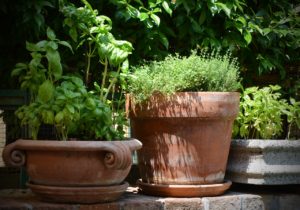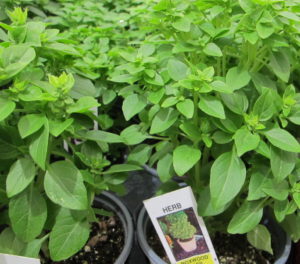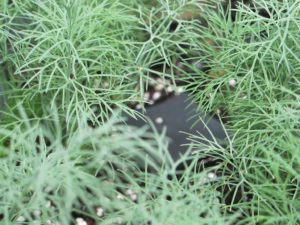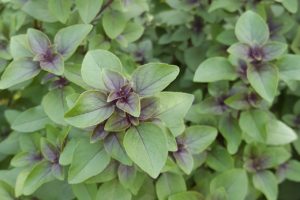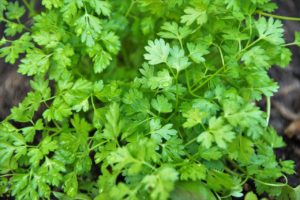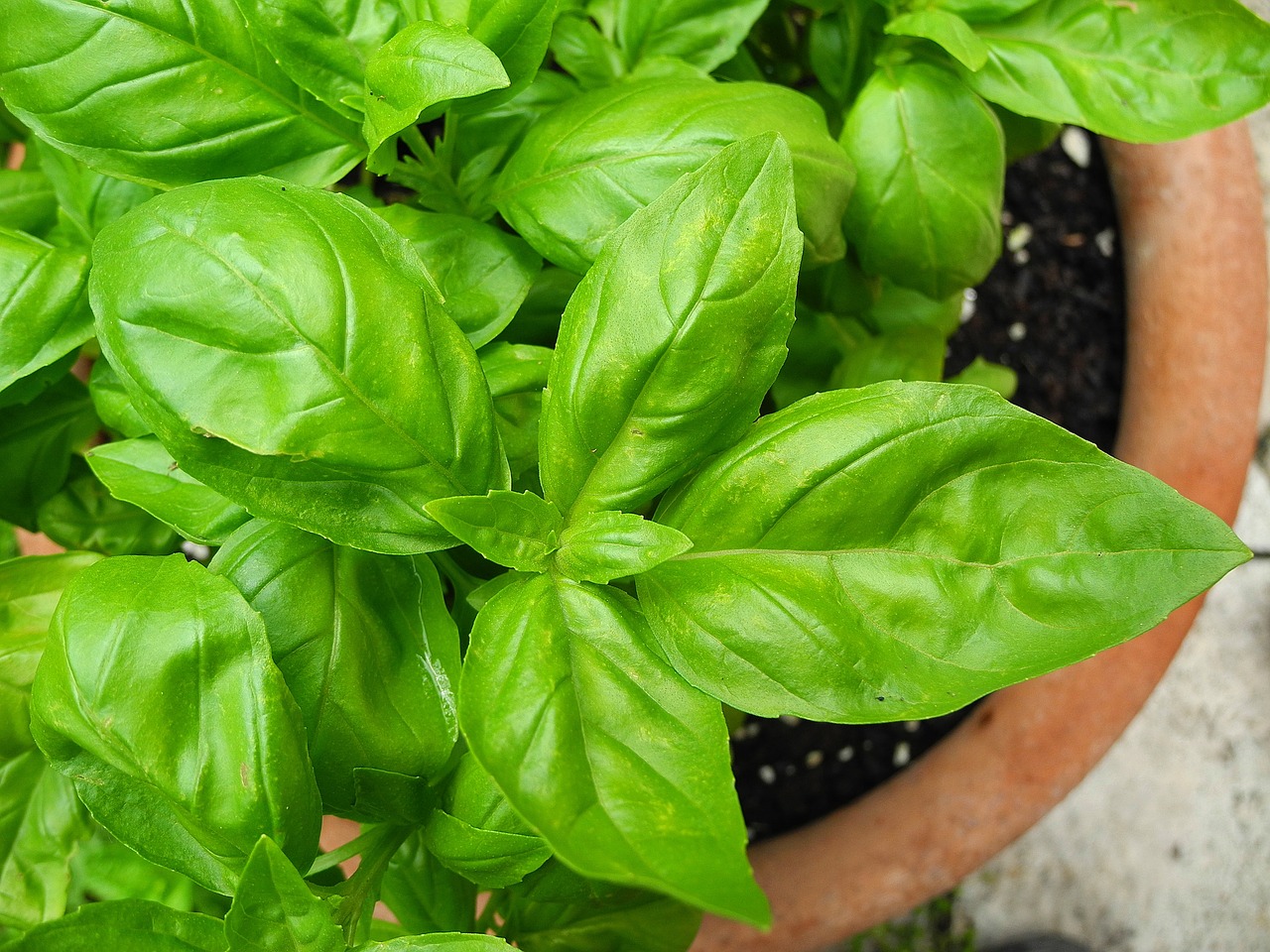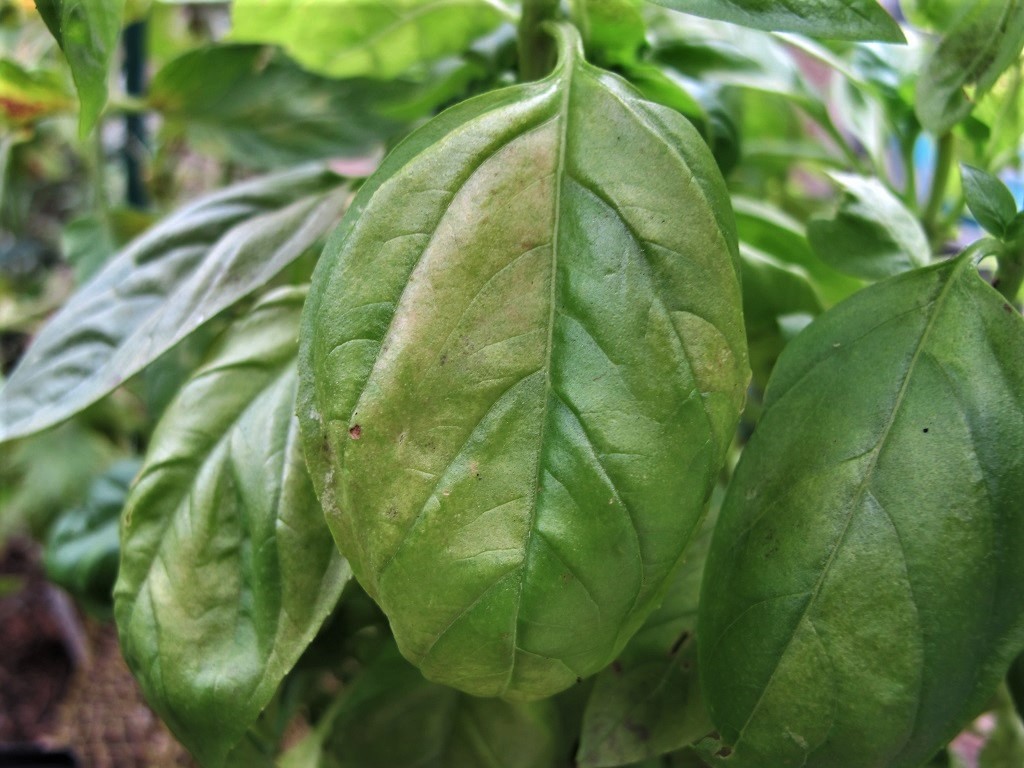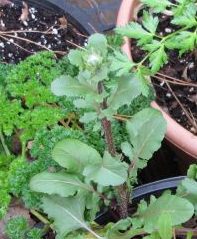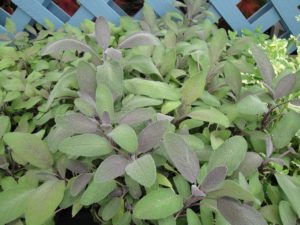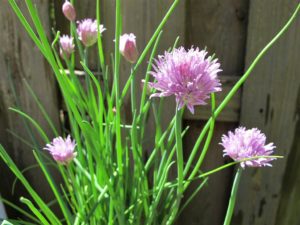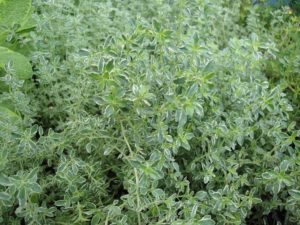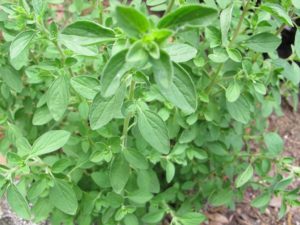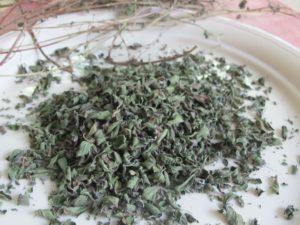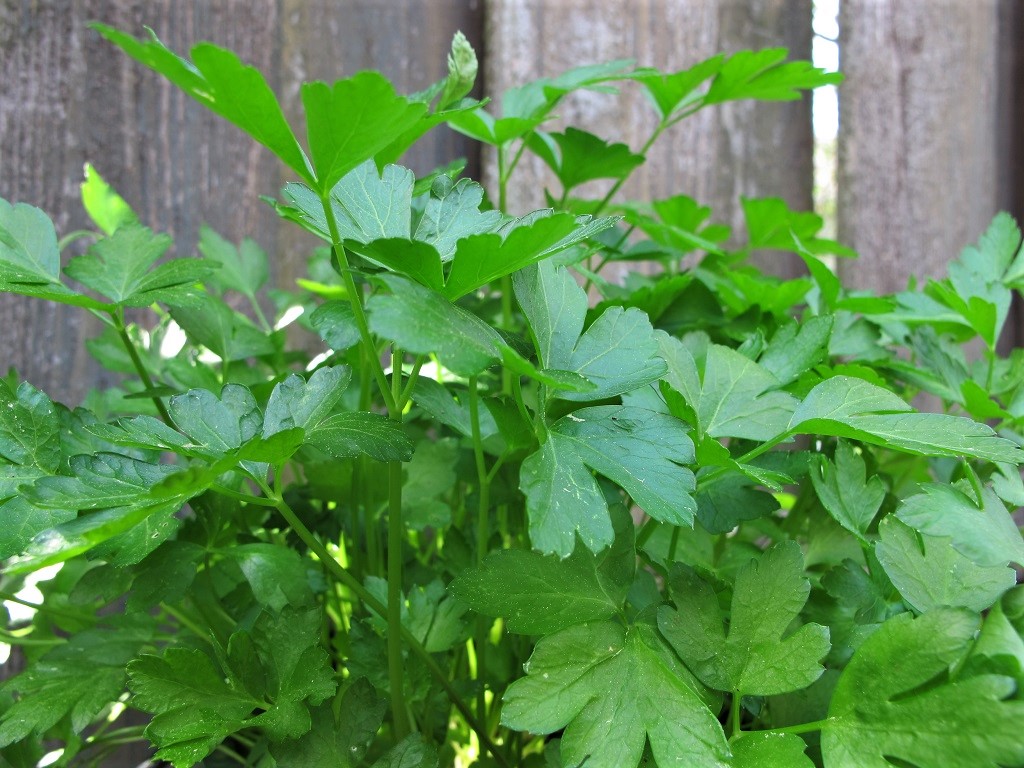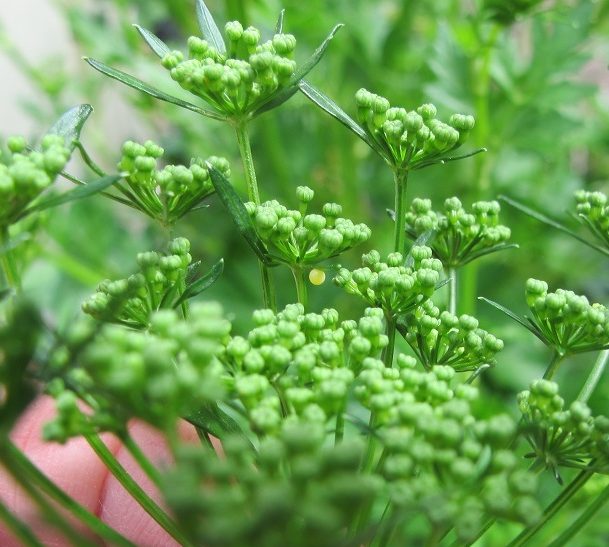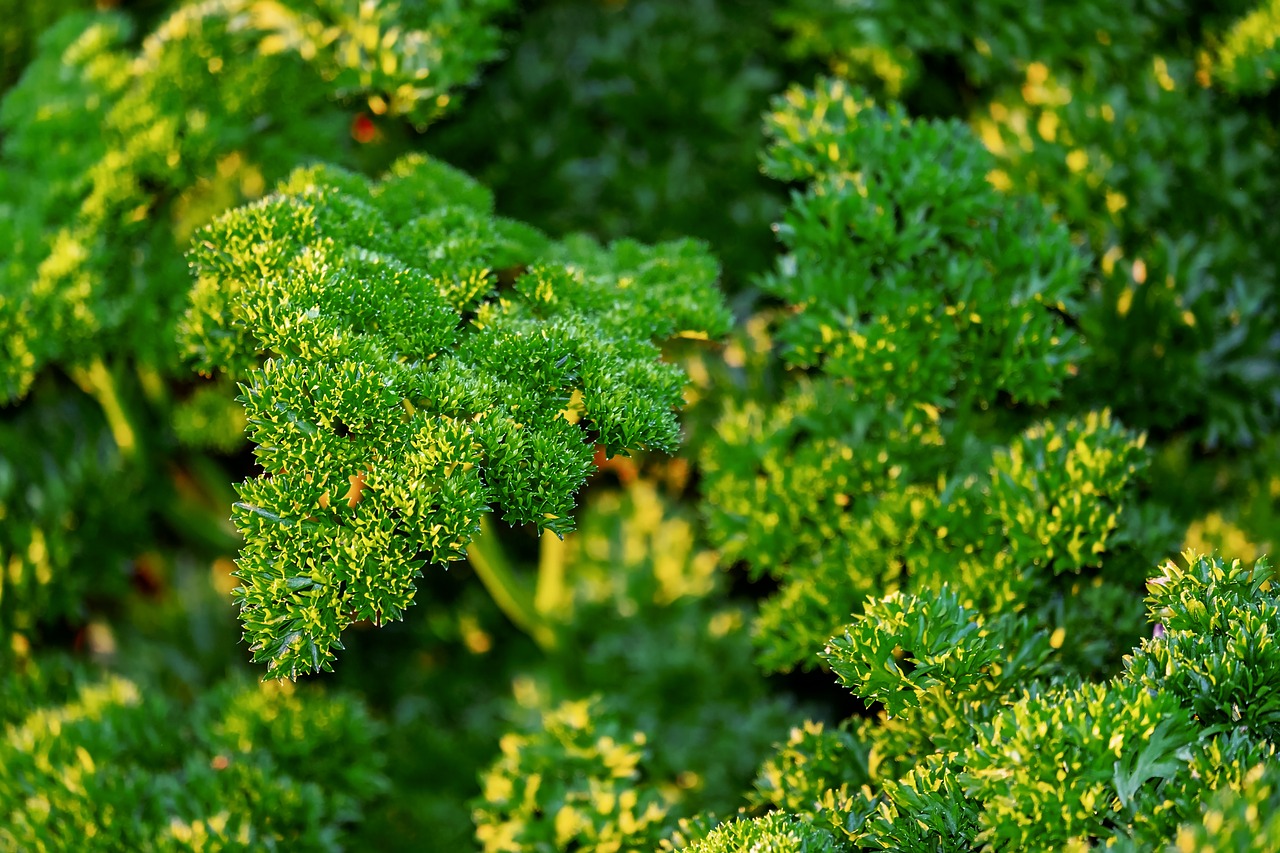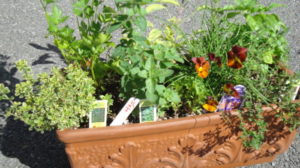Page 2
Which Herbs Are Annuals? Biennials? Perennials?
In most climates, herbs thrive when grown outdoors in summer. Basil, one of the most frequently requested annual herbs, loves warm temperatures and absolutely sulks—then dies—in the chill. Cilantro, on the other hand, prefers cool or cold weather, but still is a short-lived annual.
Many of the herbs I use in cooking are perennials. When waking from winter dormancy, new foliage emerges from the roots or the crown, or from along the stems. Combining annuals, biennials, and perennials in potted herb gardens is perfectly acceptable. Later in this article, I’ll include information on how to deal with them when they’re due for renovation.
Annuals For Herb Gardens
- Dwarf ‘Boxwood’ basil.
- Young ‘Fernleaf’ dill.
- Miniature purple basil.
- Chervil.
Annuals complete their life cycle in one growing season—from seed germination, to maturity, flowering, and pollination, and to seed again. These plants die at the end of their growing season, roots and all. Arugula, basil, chervil, cilantro, culantro, dill, and summer savory are annuals. Most annual herbs die with freezing weather, although some can tolerate chill. These annual seeds germinate within 1 or 2 weeks after sowing.
Fertility must be maintained to get the most flavor from these herbs. Lack of nitrogen, in particular, causes them to lose their rich green color. When that happens, they taste awful. More on this subject later.
Basil
Sweet basil (Ocimum basilicum) that provides a few leaves for your daily salad will grow just fine in a pot by itself. One dwarf basil thrives in a 5″ or 6″ pot or combine it with other plants in a window box. ‘Boxwood’, ‘Pluto’, ‘Spicy Bush’, ‘Yevani’, and ‘Marseillais Dwarf’ have great flavor. ‘Yevani’ is a particular favorite.
One clump containing 3 or 4 stems of a taller variety (‘Genovese’, ‘Mrs. Burns’ Lemon’, ‘Rutgers Obsession DMR’, or ‘Pesto Party’) needs a larger pot, perhaps 8″ wide. Plant three of these larger basils together in a 12″ to 14″ pot for continuous growth. They will, however, grow in smaller pots fairly successfully with careful moisture and fertilizer management.
Basil kept very potbound or underfertilized is stressed, and will go off-flavor and flower prematurely, limiting its usefulness.
- Healthy sweet basil.
- Sweet basil with early symptoms of basil downy mildew.
- Advanced BDM.
This year, I’ll keep the new disease resistant ‘Obsession’, from Rutgers University, outside all summer to test it for basil downy mildew (photo, above). Varieties that are susceptible to BDM come indoors for the night during humid weather to keep them disease-free. Fresh basil is a must-have for garden salads and Italian cuisine, so I don’t mind the effort.
The Little Chill
Basil plants growing outside might look tired by mid-summer, so harvest the remaining deep green leaves before they deteriorate. If desired, start new plants from seed to harvest until cool weather slows their growth. This herb must have warm soil to germinate and flourish. Normally, a grayish mucilaginous gel coats moistened basil seed; it helps hold moisture near the seeds and might aid seed dispersal by ants.
Start more seeds or look for vigorous young plants in late summer or autumn to grow indoors for the next few months. Although it’s a long way from frost, temperatures consistently below 60°F stress basil. That’s why it comes inside before the other herbs. It’s also why winter basil gets the warmest, sunniest spot in the house.
Basil is a special case. Let it bask in a sunny window indoors but move it farther into the room at night to keep it warmer. Aim for the high 60’s to low 70’s, and only a bit lower at night. Because I keep the house at 60° at night in winter, I place potted basil on top of the 80° aquarium during those hours.
Chamomile
German or common chamomile (Matricaria recutita) is the annual species. This one, therefore, provides lots of flowers for a restful tea in the current growing season. It grows taller than Roman chamomile (perennial), to 20-24″ tall, so it needs a larger pot.
Cilantro and Chervil
Cilantro (Coriandrum sativum) and chervil (Anthriscus cerefolium, one of the fines herbes in French cooking) thrive in cool conditions. Cilantro’s flavor is unique—many are not fond—and chervil has a delicate parsley/anise flavor.
These short-lived herbs are suitable for growing in fall and early spring gardens where summers are hot. Gardeners living in mild or cool summer climates, though, can grow them spring through mid-fall, sowing seeds every few weeks. ‘Calypso’ or ‘Cruiser’ cilantro might last all winter outdoors where the weather is moderate (zone 7 and south). These 2 varieties will grow in warm weather, although they’re short-lived. Shade them during the hot afternoon hours.
If you want to try them in a combination planter, cilantro and chervil can be paired with parsley, chives, thyme, oregano, and others that tolerate cool to moderate conditions. Even though some will die off early, it’s still a project worth taking on if you enjoy them. But cilantro and chervil generally won’t live beyond 6 to 8 weeks in herb gardens. One reason is the warmer soil; cool-loving annuals last longer in the ground.
Culantro
Culantro (Eryngium foetidum) can be called “summer cilantro” for its flavor and preference for warmer temperatures. As it ages, its leaves can get a little spiny on the margins, so pick young, more tender leaves.
Dill
Dill (Anethum graveolens), too, can be finicky, especially when grown in potted herb gardens. The dwarf ‘Fernleaf’ dill (8″), with beautiful blue-green foliage, often does well in pots. ‘Teddy’ is another small dill (14″) you might try. Dill varieties that grow to a lofty 3′ (‘Mammoth’, ‘Bouquet’) are best grown in the garden.
When shopping for dill transplants, look for pots with only a few seedlings of very young plants. Similar to its cousins in this family (Apiaceae), dill develops a tap root which resents disturbance. A pot with many germinating seeds looks fuller, but seedlings compete with each other for water, space, and nutrients.
As these plants become potbound and run out of nutrients, they’ll immediately bolt, or go to flower prematurely. If dill begins to bolt, harvest all the leaves and use or dry them. This herb doesn’t last all season, so planting a second crop is a good practice. Fall-grown plants tolerate some frost.
Cutting back mature dill stems usually will not make the plant branch out again.
Arugula
This plant (Eruca sativa) is a member of the super-healthy Brassicaceae family, along with broccoli, cabbage, cauliflower, and kale. Whether you consider arugula a vegetable, greens, or an herb, you’ll never forget its unique flavor!
I love the variety called ‘Astro’. It’s milder—less hot—than other varieties available from seed. ‘Astro’ also tolerates higher temperatures than other varieties.
Add arugula greens to liven up salads, pizza, veggie omelets, pasta dishes, and tomato sauce. Stressed in heat or poor, dry soil, it tastes quite spicy, and not in a nice way.
Arugula lives for a few to several months. It can take cold winters and summer weather, within reason, as long as the sunlight is adjusted seasonally. More sun in winter; less sun in summer.
Give arugula moist, fertile, well-composted soil in a pot or in the garden. Let the tall flower stems mature and make papery seedpods. Seeds will ripen and drop to the ground near the parent plant. Within 2-3 weeks, during its growing season, you’ll notice baby arugula plants popping up for another season’s growth. The parent plant dies after seeding.
Summer Savory
Taller growing than perennial creeping winter savory, summer savory’s fine foliage can be used in savory oils and vinegars and in bean dishes. It’s used to flavor salami. Cut back overgrown plants for a fresh crop of leaves, or let it flower for the pollinators.
At 12″ to 18″, this herb (Satureja hortensis) might be too large for small potted herb gardens, although it recovers well when cut back.
Perennials
- Purple sage.
- Chives in flower.
- Variegated English thyme.
- Italian oregano.
Perennial herbs return after winter dormancy within the USDA zones where they’re hardy. (You can find the USDA zone map under “Temperature”, on Page 4.)
Bay laurel and marjoram ‘Compactum’, for example, are hardy to zone 8, so they grow in that zone and south of it. They can tolerate temperatures as low as 10°F as long as it isn’t a sudden exposure and the plants are in the ground.
Potted plants are more susceptible to cold damage than plants in the ground, which are insulated by surrounding soil. Because roots in pots are exposed to colder temperatures, they benefit from some protection. Bay laurel, thyme, and ‘Compactum’ marjoram clustered together with other plants in a warm microclimate might survive winter cold.
Covering susceptible plants with plastic offers some protection. On colder nights, I add a string of incandescent Christmas lights inside the tent (photo, below) to add gentle warmth. When that’s not convenient, I’ll bring them indoors if the forecast calls for lower temperatures than they can tolerate.

Plastic covering and lights kept plants 15 degrees warmer. Tall stems in front—arugula going to seed.
Where It’s Hot
Hardy herbs can grow farther into the south but fail where it gets too hot. All should grow in most regions of the U.S. during the summer months, except where limited by altitude and temperature extremes.
As temperatures increase, try shading the herbs during the hot afternoon hours. You can order knitted shade cloth from horticultural supply companies or place the pots under the patio umbrella for a few hours.
Watering with cold water, except for basil, also might help. You could move the herb garden indoors to a sunny (but not too hot) window or place it under artificial lights until it cools down outside. But shading them outdoors usually suffices. Each day they spend indoors in less than optimal light, the closer they get to failing.
Herbaceous Perennial Herbs (they die down to the soil when dormant):
- bronze or leaf fennel (Foeniculum vulgare, zone 7), anise flavor, grows large, best in the garden or potted by itself. Does not form a bulb. Use in salads, herb butter, on fish, as garnish.
- chives (Allium schoenoprasum, zone 3), pinkish purple flowers after winter, salads, herb butter or cream cheese, baked potatoes; harvest by cutting leaves to the ground, new foliage will emerge from small bulbs in the soil.
- French tarragon (Artemisia dracunculus, zone 6), one of the fines herbes of French cuisine, anise flavor, started from cuttings or division, not from seed. Where summers are hot, grow in the ground, lightly shaded in the afternoon, or dry early shoots from potted tarragon. A little bit goes a long way.
- lemon balm (Melissa officinalis, zone 4), nice lemon flavor and scent, good in drinks, salads. Goldfinches eat seeds in late summer.
- lemongrass (Cymbopogon flexuosus, zone 9), grows large, best by itself; soups, tea, curries, stir-fries.
- lovage (Levisticum officinale, zone 4), celery flavor, large grower, for soups, stews, poultry, and potatoes. Use tender young leaves in salads.
- marjoram (Origanum majorana and others, zones 4 to 8), might hold some foliage through winter, herbaceous or semi-woody. I like ‘Compactum’ (zone 8) for its sweet, velvety leaves. Use with eggs, fish, vegetables, and in soup. Oregano substitute.
- Mexican mint marigold (Tagetes lucida, zone 8 or 9), French tarragon substitute in warmer climates. Gold flowers.
- mint (Mentha spp., zone 4), many flavors (spearmint, peppermint, chocolate, apple, orange…), best by themselves, invasive. Mint cross-pollinates with other mints; don’t let it flower, as seedlings can have poor or no flavor. Salads, drinks, jellies.
- oregano (Origanum vulgare, zone 4 or 5), can hold some leaves close to the crown in winter. Italian oregano is sweeter and less peppery than Greek oregano. Golden oregano—little flavor, scorches in full sun, but pretty as ground hugger in open air. For soups, meats, Italian cuisine, salad dressing, tomato sauce, pizza, butter sauce for fish.
- Roman chamomile (Chamaemelum nobile, zone 5), herbaceous, fragrant foliage, not as many flowers for tea as the annual species of chamomile. Sometimes planted as a fragrant chamomile lawn, or under a bench.
- sorrel (Rumex acetosa [green leaf], R. sanguineus [red-vein, photo, below], zone 4), very early lemony greens for salads, soup, fish. Young greens taste the best.
- winter savory (Satureja montana, zone 4), wonderful aroma, creeping variety works well in herb gardens, good with beans, soups.
Woody Perennial Herbs (they regrow from stems):
- bay laurel (Laurus nobilis, zone 8), woody evergreen, can drop leaves in cold, windy winter; might revive (give it 2 months), might not. Symbol of wisdom and glory. Many cooks prefer dried bay leaves. Use in soups, sauces, with fish.
- lavender (Lavandula spp., zone 5 to 9, depending on variety), evergreen to partially evergreen, best in the garden or by itself in a clay pot. Super-fragrant lavender needs excellent air circulation and full direct sunlight.
- lemon verbena (Aloysia triphylla, zone 8 or 9), cut back to reinvigorate, powerful lemon scent, flavor.
- rosemary (Rosemarinus officinalis, zone 7 or 8), evergreen shrub; upright and trailing, dwarf and large, variegated varieties. Use with meats, vegetables, seafood. The “herb of remembrance”.
- sage (Salvia officinalis, zone 5), woody perennial, drops most leaves in winter, shrubby. Silver-leaved sages have stronger flavor than purple or golden, but all are edible. Not recommended consuming in large quantities due to estrogenic compounds. Dwarf silver sage has good proportions for herb gardens. Less hardy pineapple sage grows large, has wonderfully fragrant foliage, and red flowers for hummingbirds.
- stevia (Stevia rebaudiana, zone 9), super-sweet leaves, grown as an annual or tender perennial, dried and ground.
- thyme (Thymus spp., zone 5 or 6), woody perennial, drops most leaves in cold winters, creeping to shrubby. French thyme and ‘Dot Wells’ English thyme have great aroma and flavor. Use with fish, meats, poultry, soups, eggs, sauces. Golden lemon thyme is popular, both culinary and ornamental.
Staying Potbound
Many herbs don’t mind being potbound, where the roots are confined in a pot. Those include bay laurel, chives, lavender, lemon verbena, oregano, rosemary, sage, savory, and thyme. In fact, they can decline when overpotted, particularly during wet weather. A large soil volume holds more water than they like, taking longer to dry out.
I have grown these herbs for several years in 4½” pots, closely monitoring soil moisture. (Taking a long weekend? Find someone with whom you can trade plant sitting services.)
Shrubby herbs with healthy roots and in good growing conditions can be cut back quite hard. Like other woody shrubs, they’ll branch out again. When presenting wrapped gifts to aspiring cooks, attach a few sprigs of fresh herbs tied with raffia for a nice finish.
Above all, cut most of the best-quality foliage while it’s in its prime. Use the trimmings fresh or dry them for future use. That’s what I do when there’s an abundance of oregano, sage, thyme, bay, or marjoram.
As long as soil moisture, fertility, and plant size are managed properly, most plants will thrive in a potbound condition.
And Biennials
- Flat-leaf parsley.
- Yellow egg, in center, laid by black swallowtail butterfly on parsley flower bud.
- Curly parsley.
Parsley
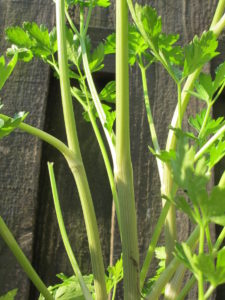
Parsley’s tall flower stems.
Curly and flat-leaf parsley (Petroselinum crispum) are popular biennial herbs. It is one of the three fines herbes, with chervil and French tarragon. You can start them any time of the year, but the seeds can be slow to germinate. Growers sometimes suggest pouring hot water over the seeded pots for the first watering.
Deep green leaves emerge from the center of the rosette all spring, summer, and fall. In regions with moderate winters, parsley grows well into cold weather. This herb grows quite easily indoors.
For flavor, it’s a personal preference. I like the stronger-flavored flat-leaf parsley (also called plain or Italian). Curly parsley also is used as a garnish, as a decorative edging in gardens, and as a filler in ornamental combination planters.
Going To Flower
Cold weather later in the growing season initiates parsley’s reproductive stage. Anywhere from late winter through spring, the plant will grow tall stems with increasingly smaller leaves (photo, above). Then, flower buds develop at the tips of the stems.
At this point, before the leaves lose good flavor, harvest and rinse them, and either use the leaflets in cooking or pack them in a container and freeze them. Freezing the foliage causes it to wilt, but the flavor is still good for soups, sauces, and cooked dishes.
Typical of biennials, these plants go to flower after the first cold period, and then they die. Normally, we get almost a year’s pickings from parsley.
At Times, It’s Short-Lived
When seeds germinate very early in the calendar year, however, parsley can flower in the first summer. Whether it’s due to an early spring chill or to a long growing season, these plants might fall short of a full year’s harvest.
Young parsley planted in early autumn will survive the cold in moderate climates, and resume growth in late winter or spring. Consider protecting the plants in colder climates to get more production out of them.
Cutting back a parsley plant that has begun to flower rarely returns it to a productive status. Occasionally, a seedling in the original clump that had been crowded but remained alive might start growing. This happened in my garden a couple of years ago, when a curly parsley (in the photo of arugula) started growing after all the flat-leaf parsley had been harvested.
Varieties of Parsley
You’ll find curly parsley in several varieties, including the moss curled types, ‘Wega, ‘Paramount’, and ‘Darki’.
The newly introduced ‘Menuette’ has beautiful finely incised deep green foliage. (***Update***: I grew this one for the first time in 2023, and it survived the winter in pots.) Like other curly parsley varieties, this one grows about 10-16″ tall.
I love growing ‘Giant of Italy’ (or ‘Gigante’) parsley. This variety can spread more than 3′ wide in fertile soil. In the past, I’ve grown ‘Titan’, a smaller flat-leaf variety that fits well in potted herb gardens.
Parsley flavors dressings, sauces, soups, salads, eggs, vegetables, potatoes, Italian cuisine, fish, and meats. This versatile herb has high levels of vitamins and nutrients, including iron. Chewing on a leaf freshens the breath.
We’re not the only ones who appreciate parsley’s fine qualities. You’ll need to protect it from rabbits, deer, and caterpillars of the black swallowtail butterfly. Other animals, too, might find it irresistible.
Par-Cel
Related to parsley, celery, dill, and other species in the Apiaceae family, Par-cel rarely shows up in garden centers. I used to grow it for the farmers’ markets, and my customers loved its robust celery flavor. Par-cel is a Dutch variety of cutting celery (Apium graveolens). You guessed it; it looks like a cross between parsley and celery. But it’s easier to grow than celery and has thin stems.
Grow Par-cel (Apium graveolens var. secalinum) in very fertile soil, always kept moist. You’ll find stronger flavor (maybe too strong) in leaves grown with less water and fertility, in older leaves, and in hot weather. Use these in cooked dishes, such as soups, stews, and vegetables. But grown with lots of water and nutrients (especially nitrogen), freshly picked leaves will make your egg, tuna, and chicken salads “sparkle”. It’s also a beautiful plant!
I estimate its hardiness at about USDA zone 8. If it survives the winter, it will flower the next season. Shade the plant during hot afternoon hours in summer. Because of its vigorous nature, plant it by itself or with other herbs that take the same conditions, in large pots.
***Update***: During the winter of 2022-23, cutting celery (not Par-cel) survived the sudden drop to 4°F in December in my zone 7 garden. This huge clump is now beginning to go to flower. I’ll harvest some of the foliage and freeze it for homemade soups. 5/10/2023
Viola
Add a little color to your herb gardens in cooler seasons with viola (Viola tricolor; V. cornuta is a perennial), a smaller cousin of the pansy. I’ve never detected much flavor, but leaves and flowers are high in vitamin C. And, of course, they’re pretty.
Since violas are normally grown for their ornamental value, ask the grower if the plants have been sprayed with pesticides. Or start your own plants from seed in late summer or mid-winter. Harden them off properly if planting outdoors in frosty weather.
In the window box, below, the viola will decline in warm weather. Just remove the dead stems, and the other herbs will fill the space. Violas sometimes self-seed.
Headings:
Page 1: The Gift That Keeps On Giving, Choosing the Right Containers for Herb Gardens (Style and Size, Window Boxes, Long Toms, Plain Pots, Pot Color), Choosing the Right Plants for Herb Gardens (A Proper Fit, Seeds and Transplants, What’s the Difference Between Herbs and Spices?)
Page 2: Which Herbs Are Annuals? Biennials? Perennials?
Page 3: Herb Gardens Close To the Kitchen, Combination Pots, Potting Up Herb Gardens, How To Maintain Herb Gardens (Light, Natural Sunlight, Artificial Light)
Page 4: Tips For Watering Herb Gardens (Transpiration, Why Plants Wilt, Testing for Moisture, From Season To Season, Water Temperature), Fertilizing Herb Gardens (Organic or Synthetic?, Macronutrients and Micronutrients, How Often To Fertilize Herbs, When We Don’t Fertilize, The Taste Test), Temperature (As Temperatures Change)
Page 5: Common Pests (Better Options To Eradicate Pests, Bacillus Thuringiensis, Horticultural Oil, Organic Sluggo, Plain Water), Girth Control (It’s Thyme For Drying, Which Herbs Dry Well?), Renovating Herb Gardens (Propagating Herbs)
